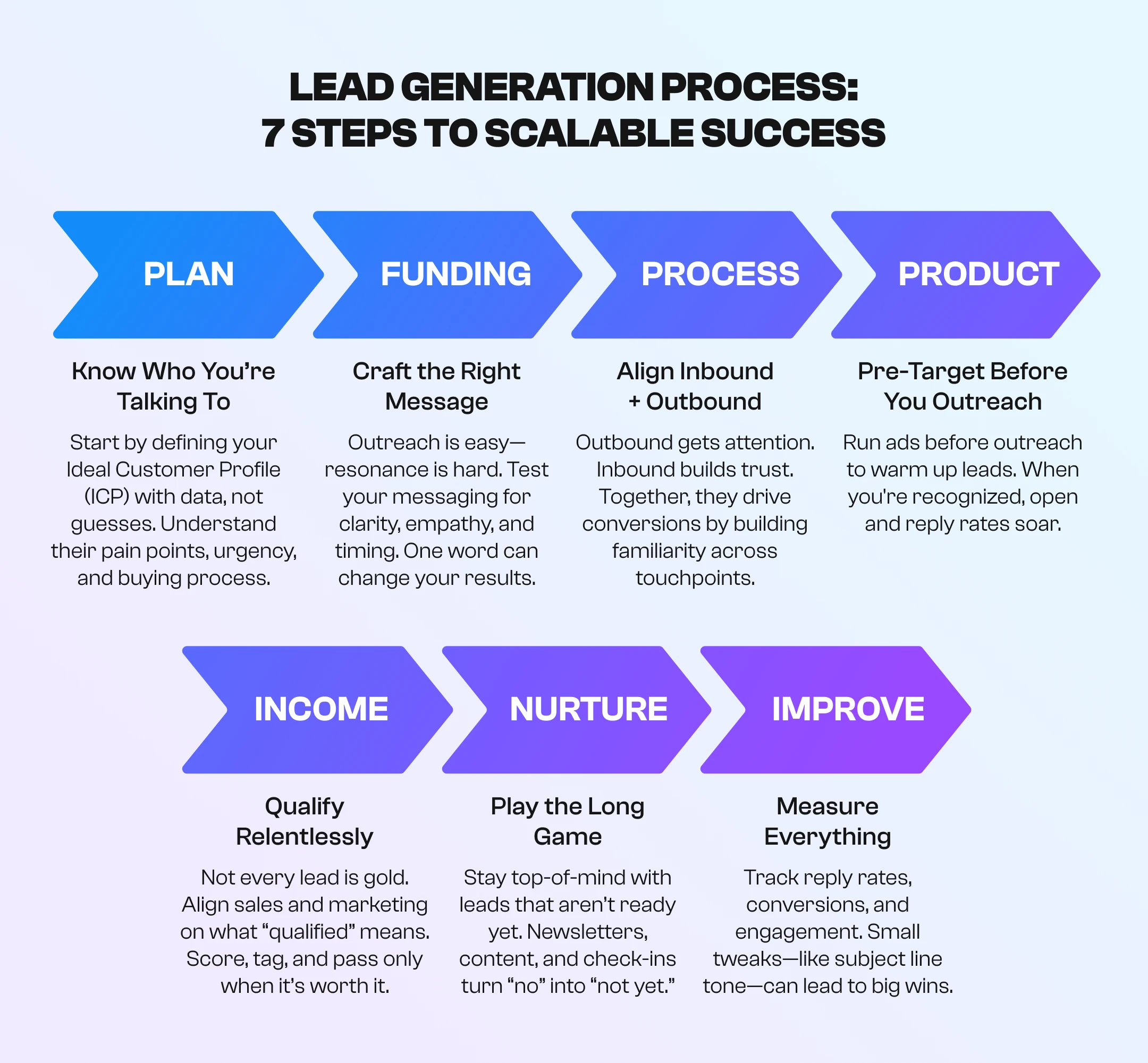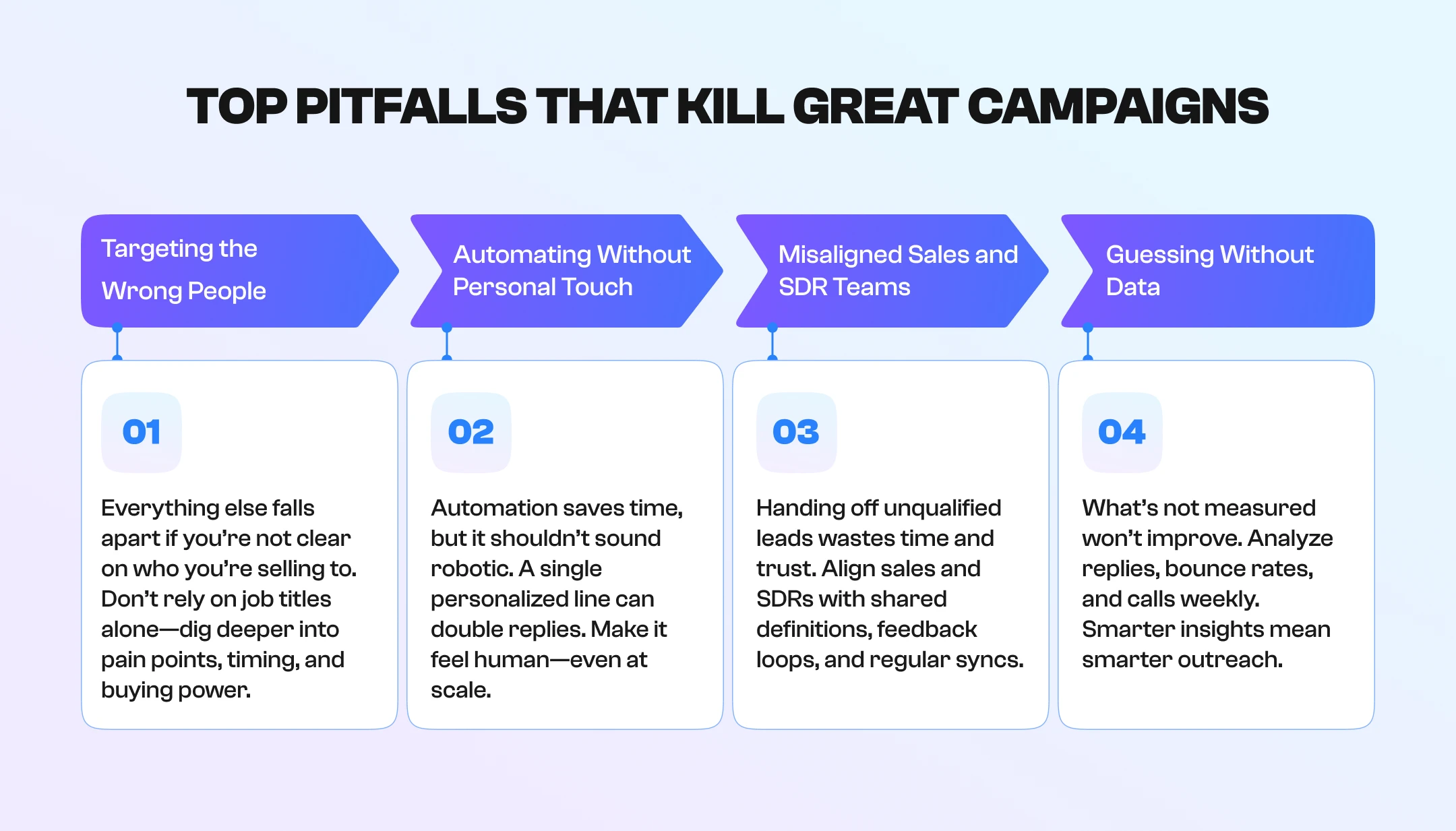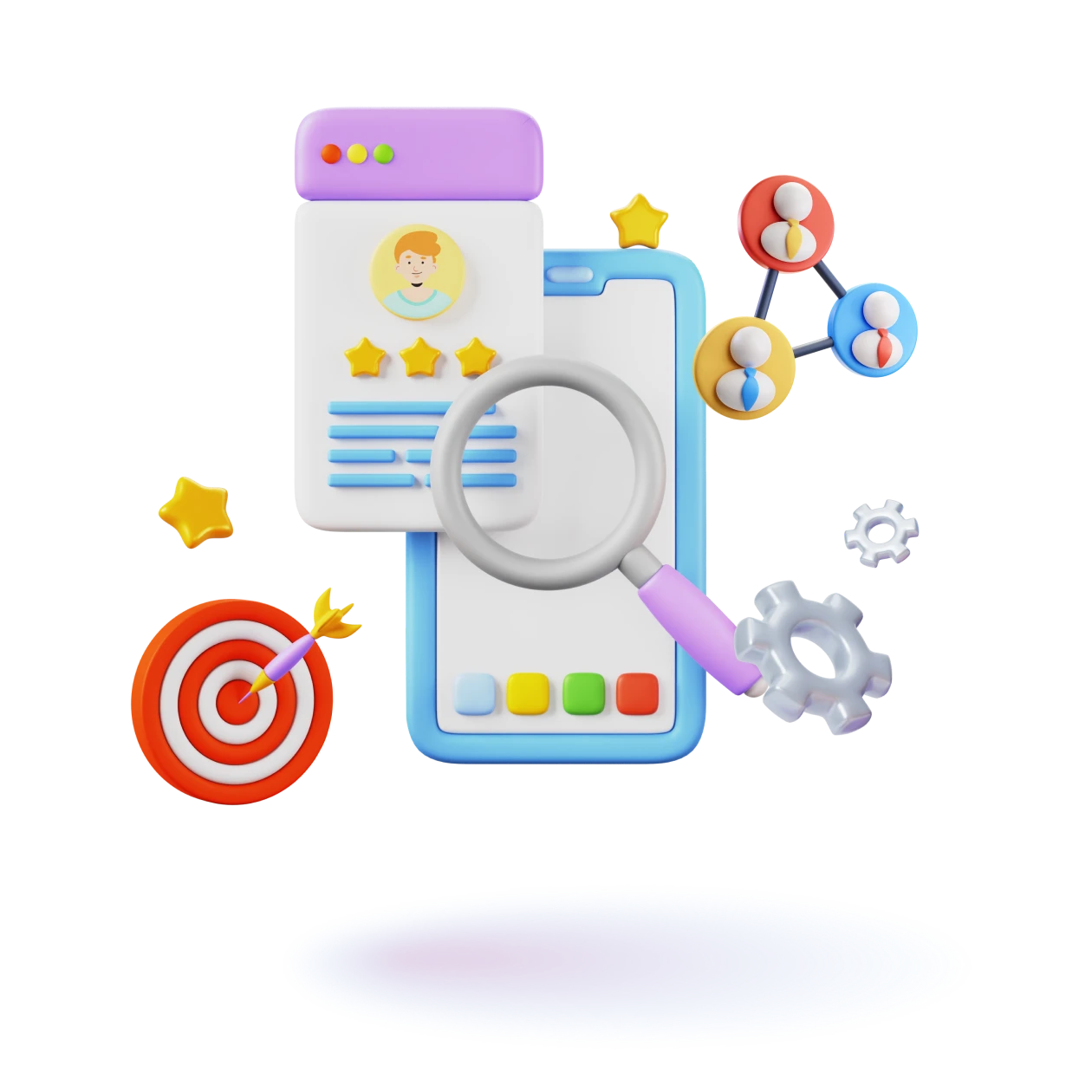Truly understanding what the lead generation process means transforms it from guesswork into a repeatable, strategic method. Let’s be honest, it’s rarely perfect the first time around.
When we started SalesAR, we grabbed a tool, pulled a list, wrote a few cold emails, and hit send. The results? Underwhelming. We blamed the list, the subject lines, the timing. But deep down, we knew the truth—we didn’t have a real process.
So we went back to square one. We broke down every step, handoff, and message. We tested relentlessly, scrapping what didn’t work, then doubling down on what did. Slowly, our B2B lead generation process got better. Eventually, the system we built started producing a real, consistent pipeline for 100+ clients across SaaS, tech, and B2B services.
According to HubSpot, 59% of marketers say generating high-quality leads is their biggest challenge. We get it. That stat doesn’t surprise us. Most teams don’t fail because of a lack of tools or ideas—they fail because they operate on guesswork instead of a system.
Here’s how to improve the lead generation process — exactly how we improved ours.
Why the Process Is the Strategy
What is lead generation process, exactly? Lead generation is a structured approach to identifying, attracting, nurturing, and converting prospects into qualified sales opportunities. Knowing what a genuine lead generation process means prevents you from buying lists and hitting send.
We’ve seen it repeatedly: teams throwing tools, money, and messaging into the void, hoping something sticks. There is no clear targeting, no real segmentation, no understanding of timing, pain points, or buying triggers.
When that happens, it’s not just inefficient—it’s a waste of your best resource: time.
Solid lead generation processes build momentum. They keep your team focused, your messaging sharp, and your pipeline full of qualified conversations. They also force clarity: Who are we selling to? Why now? What’s the next step?
Here’s the kicker—when your process is dialed in, the results become repeatable. Suddenly, you’re not hoping for leads.
Your B2B lead generation process should be as proprietary as your product. That’s what creates predictable revenue.

Step 1: Know Who You’re Talking To
A client once said they wanted to target “SaaS companies.” Broad category, right? Sounds fine on the surface. But when we asked to describe their best customers, they got vague—“anyone with a software product.” That’s a recipe for wasted outreach.
So we pulled their CRM, looked at their most successful closed deals, and cross-referenced them with intent signals. It turned out that 85% of their ideal buyers were in healthcare tech, with fewer than 200 employees, slow internal processes, and a real urgency to modernize. Suddenly, the messaging changed, as did the lead quality.
This is why the first step in the lead generation process isn’t about sending emails or running ads. It’s about understanding exactly who you’re trying to reach, what problems they’re trying to solve, and when they’re likely to care.
A successful sales process lead generation starts with clearly defining your ICP beyond size and industry. It’s about:
- Who makes the buying decision?
- What keeps them up at night?
- Do they have the budget?
- How urgent is their problem?
- What does their buying process look like?
To get those answers, we use:
- Competitor analysis – Who are they targeting? What gaps can we fill?
- Enrichment tools – Think Clearbit, Apollo, or ZoomInfo to enhance lead data with job roles, tech stacks, or revenue bands.
- Buyer intent platforms – Tools like Bombora or G2 tell us who’s researching what, right now. That means we’re not just guessing who might need you—we’re seeing who’s already looking.
Why go to this level of detail? Because when you speak someone’s language, they listen.
Personalizing up to 20% of your emails can double your reply rate. That’s not a tweak. That’s a game-changer.
Step 2: Build the Message that Starts Conversations
Outreach is easy. Resonance is hard.
Anyone can hit send on a sequence. But what is the difference between a cold message that gets ignored and one that gets a reply? That’s where the real work happens.
We test 4–6 variations of every message before considering scaling it. Because what sounds good in a brainstorm often flops in the inbox. Sometimes, it’s not about rewriting the whole message—it’s about tweaking one word.
A real example: We worked with a fintech client targeting CFOs. The original line was: “Do manual reporting workflows challenge you?” Crickets. We changed it to: “Are you frustrated with manual reporting workflows?” Reply rate doubled.
Same sentence structure. Just one word with more emotional weight.
That’s how specific messaging has to be. It’s not just about clarity—it’s about empathy. You want your prospect to read that line and feel like you’re already in the middle of their internal monologue.
At SalesAR, our B2B lead generation process focuses on:
- Tone: Is this conversational or robotic?
- Structure: Is there a clear hook, value prop, and CTA?
- Relevance: Are we solving their problem or pitching our product?
- Timing cues: Are we aligning with something they’re likely dealing with right now?
Messaging is the one thing everyone rushes to do. It’s usually the one thing breaking their campaign.
If your leads aren’t responding, don’t rush to blame your email list or sender identity. Start by refining your messaging.
Step 3: Outbound and Inbound Aren’t Enemies
Picture this: A CEO sees a smart LinkedIn post from your brand, LinkedIn being just one of the most popular inbound channels. Later, they encounter a remarketing ad while reading an industry article (another inbound touchpoint). The next morning, your personalized cold email lands in their inbox—that’s outbound.
Now you’re not a stranger—you’re familiar. Trust isn’t built in silos, it’s built in layers.
We’ve seen the difference firsthand. The outbound lead generation process alone can surely generate quick results. But when those same prospects also see applicable content, read case studies, or watch videos from your team, reply rates go up, and deals move faster. Why? Because your name already means something before the first call happens.
That’s why we often sync campaigns like this:
- Email and LinkedIn messages spark the conversation.
- Social content and ads reinforce the message.
- Landing pages and case studies close the loop with proof.
Stat to keep in mind: 89% of B2B marketers use LinkedIn for lead generation, and 62% report it produces leads effectively. That’s not just noise. That’s where your buyers are paying attention.
So stop thinking in terms of channels. Think in terms of attention. Wherever your prospects are, you should be consistent and have a message that makes them want to talk.
Step 4: Pre-Targeting & Multichannel Touch
Before you ever send a message, your prospect should know your name.
We once ran a campaign that started with pre-targeting instead of sending cold emails immediately. Our outbound lead generation process B2B involved branded ads shown for five days before any email outreach. The copy and offer were the same, but open rates jumped from 23% to 47% when the emails landed. Why? Because we weren’t strangers anymore.
That’s the power of multichannel done right. It’s not about being everywhere just to tick boxes—it’s about showing up at the right time with the right touch.
Here’s how we mix channels:
- Email for direct, personalized messaging
- LinkedIn for visibility and warm engagement
- Retargeting ads to build familiarity
- Voice drops for that unexpected, human nudge
The goal of our outbound lead generation process isn’t to overwhelm prospects—it’s to familiarize. Perhaps they see your ad on Monday, receive your email on Wednesday, and get a LinkedIn connection request on Friday. When they reply, it doesn’t feel cold—it feels familiar.
Every channel has a moment. The art is in knowing when to use which. Multichannel works best when it feels natural. Sequenced. Intentional. You’re not forcing the conversation—you’re earning it.
Step 5: Qualify Like Your Time Depends on It
Before passing a lead to sales, you need to be confident it’s worth their time— that’s exactly where the lead generation qualification process comes in. No matter how well you execute the earlier stages, if this step is missing, the entire process of lead generation breaks down. Qualification ensures the right conversations happen at the right time with the right people.
Not every lead is gold. Chasing the wrong ones doesn’t just waste time—it clogs your pipeline, burns out your sales team, and hurts your close rate.
We worked with a client who believed generating more leads would result in more deals. However, their pipeline was flooded with curious, uncommitted people. We helped them trim 30% of that noise, and they ended up closing more deals with less effort. Why? Because they focused on the right conversations.
Whether you call them MQLs, SQLs, or PQLs, the real key is alignment. Sales and marketing must agree on the following: what does a qualified lead look like? Not in theory—in practice. Role, budget, urgency, authority. If those boxes aren’t checked, it’s not ready to move forward.
We build this directly into our lead generation qualification process. Lead scoring isn’t just something you do in a CRM—it should guide your outreach. That’s why we often embed qualification criteria into the sequences themselves. Every reply gets tagged. Every call gets scored. We know exactly when to pass the baton to sales.
Stat to keep in mind: Companies that align sales and marketing see a 36% higher customer retention rate. Better retention always starts with better qualification.
Your time is your most expensive resource. Don’t spend it on leads that will never convert.
Get the free PDF: The strategy behind our best-performing campaigns.
Step 6: Nurture What Doesn’t Close (Yet)
Just because they didn’t book today doesn’t mean they won’t buy tomorrow—that’s the foundation of our lead generation nurturing process.
Too many teams write off leads after one or two touches. They move on to the next shiny contact if there’s no reply. That’s a massive miss. We’ve seen it repeatedly play out—those “cold” leads? They’re not cold at all. They’re just early.
One client closed a $50,000 deal with a prospect we first reached out to nine months earlier. The lead ghosted the first few messages, skimmed a newsletter, clicked a link in month four, liked a LinkedIn post in month six, and finally replied, “Hey, we’re ready to talk.”
This didn’t happen by chance. It was part of a long-game play we baked into the lead generation process from day one.
Here’s the thing: not everyone’s in buying mode when your message hits. But if you consistently stay top-of-mind—with value, not spam—they remember you when the moment is right.
At SalesAR, our lead generation nurturing process includes:
- Light-touch check-in emails every few weeks or months
- Monthly newsletters packed with relevant insights, use cases, or benchmarks
- Targeted LinkedIn engagement—a comment here, a share there, sometimes a short DM
- Helpful resources like industry reports, playbooks, or templates
We don’t push. We plant seeds. If a lead says “not now” but fits the ICP, they enter directly into our lead generation nurturing process. There is no hard sell. These are just strategic reminders that we exist and understand their world.
If you treat every prospect like a short-term win, you’ll burn many bridges. But if you treat your pipeline like a garden—tending to it regularly, giving it time—you’ll find opportunities sprouting up when you least expect.
The close doesn’t always happen fast. But it does happen when the process stays consistent.
Step 7: Measure, Learn, Improve
Every sales process lead generation campaign is tested, tracked, and tuned weekly. Subject lines, message tone, CTA placement, send times—nothing is left untouched.
Optimization isn’t a one-off task. It’s the engine behind everything that scales. Our dashboards track:
- Reply rates (Are we starting conversations?)
- Bounce rates (Is our data clean?)
- Lead-to-opportunity conversion (Are the right people showing interest?)
- Meeting-to-deal ratio (Are meetings turning into revenue?)
One of our fastest wins came from a single A/B test on a subject line. Just a softer tone—same offer, different phrasing—and reply rates jumped 19% in a week. That kind of insight doesn’t come from guessing. It comes from tracking what matters.
Understanding how to improve the lead generation process with minor adjustments creates a powerful compounding effect. When you measure the right things, you’re not just reacting to results but engineering.
Knowing what the lead generation process means is critical for any team aiming to scale sustainably. It’s not just a set of actions—it’s a mindset shift. Instead of random outreach and reactive messaging, the process of lead generation aligns your team around a repeatable framework that builds momentum over time. That’s when lead generation stops being a guessing game and becomes a strategy.
Pitfalls That Kill Great Campaigns
Let’s be honest—most campaigns don’t crash because you didn’t send enough emails. They crash because something fundamental is broken in your lead generation process before the first message goes out. You’d be surprised how often we get brought in to “fix” a campaign, and the root issue isn’t the tech, or the copy—it’s the assumptions.
Here are the common pitfalls we see often:

Poor ICP Definition
Everything else unravels if you’re not laser-clear on who you’re targeting. It doesn’t matter how clever the message is—if it lands in the wrong inbox, your sales process lead generation efforts are dead on arrival. We’ve seen companies go months targeting titles that sound relevant but have zero decision-making power. Or worse, targeting companies that aren’t even in-market. The fix? Go deeper. Real ICPs include company stage, pain points, buying triggers, and timing indicators—not just industry and headcount.
Over-Automation Without Personalization
Yes, automation saves time. But don’t expect anyone to reply if your message reads like it was built in a spreadsheet. The best outreach feels written for one person, even if sent to 1,000. We’ve seen reply rates double just by adding one custom line, like referencing a recent funding round or a podcast the lead appeared on. Use automation to scale efficiency, not at the expense of authenticity.
SDRs and Closers Are Not Aligned
This one silently kills momentum. SDRs book meetings that look great on paper, but the AEs get on the call and realize the prospect wasn’t qualified, or doesn’t even know what the call is about. That disconnect breaks trust, wastes time, and hurts win rates. Fix it by having shared definitions, regular syncs, and post-call feedback. The tighter the loop between top-of-funnel and bottom-of-funnel, the smoother everything runs.
No feedback Loop
You can’t improve what you’re not analyzing. If your team isn’t reviewing responses, looking at bounce patterns, listening to call recordings, and updating playbooks based on what they learn, the campaign will plateau fast. It’s not about running more sequences. It’s about making the current ones smarter every week.
“Most campaigns don’t fail because of low volume—they fail because they’re built on assumptions.”
Great campaigns are built, not guessed. And the ones that scale? They’re constantly adjusting based on what’s working, what’s not, and what’s changed since last week. Don’t skip the fundamentals. They’re what keep the engine running when the volume ramps up.
Common Myths About Lead Generation
Myth #1: More leads = more sales
Volume without quality leads to bloated pipelines, low conversion, and sales burnout. A well-defined lead generation qualification process filters out noise and prioritizes real opportunities.
Myth #2: You only need one good channel
Relying on a single channel is risky. A strong B2B lead generation process blends outbound and inbound, building trust and visibility across multiple touchpoints.
Myth #3: Once a lead says “no,” they’re gone
Many “no’s” are really “not yet.” That’s why the lead generation nurturing process matters—people buy when the time is right, not when you first reach out.
Real-World Lead Generation Process Examples
Theoretical frameworks are helpful, but real-world execution is where accurate insights emerge. At SalesAR, we’ve seen firsthand how optimizing even a single stage of the lead generation process can dramatically affect revenue. Here are two examples:
Example 1: SaaS Startup with Undefined ICP
A Series A SaaS company approached us with poor reply rates and confused messaging. Their outreach targeted “any business with a digital presence.” After running an ICP audit, we found their most engaged prospects were in logistics tech with 50–200 employees. We redefined their buyer persona, aligned outreach around industry-specific pain points, and implemented a more straightforward lead generation qualification process. Within six weeks, reply rates jumped by 63%, and they booked 34 qualified meetings from the same size list.
Example 2: Mid-Market Tech Firm Lacking Nurturing Strategy
Another client had strong outbound performance but couldn’t convert delayed or passive leads. We introduced a multi-touch lead generation nurturing process—targeted newsletters, LinkedIn drip content, and occasional check-ins based on intent signals. One dormant lead turned into a $90,000 deal after nine months of strategic follow-up. That’s the power of staying top-of-mind.
These aren’t outliers—they’re proof that refining the lead generation process at key points can create a sustainable impact. Whether it’s ICP definition, qualification, or nurturing, each layer adds to a compounding advantage.
Conclusion
If you’re building your first campaign or refining your tenth, take a moment to step back and ask: Do you truly understand what the lead generation process means for your business? It’s more than outreach—the blueprint turns leads into lifetime customers. Get the process of lead generation right, and everything else flows from there.
That’s the truth we learned early about the process of lead generation—and see it proven repeatedly. The companies that consistently win aren’t necessarily using better software. They’re using better systems. They’ve taken the time to align people, tools, and timing into one clear rhythm that turns interest into conversations, and conversations into revenue.
That’s the difference between “we hope this works” and “we know it will.”
A strong lead generation process B2B doesn’t just get you leads. It gives you leverage to forecast better, scale faster, and build a pipeline that doesn’t dry up when someone goes on vacation.
If you’re still chasing leads, your process is chasing its tail. When your system works, the right leads come to you—and stay.
Want a lead generation process that works?
Take a minute and ask yourself: Which part of your lead generation sales process needs attention? Is it the ICP, the messaging, the follow-up, or the alignment between teams? Whatever it is, we’re here to help.
Book a consultation with SalesAR. Let’s build a system that fits your pipeline and your selling style.
FAQ
1. What is lead generation process?
The lead generation process is a systematic approach to attracting potential customers, engaging them with relevant messaging, and converting them into qualified sales leads. It involves identifying the ideal customer, reaching them through targeted channels, nurturing interest, and qualifying their intent before moving them into the sales funnel.
2. What is a B2B lead generation process?
A B2B lead generation process refers to strategies and steps used to generate leads in a business-to-business context. It typically includes ICP definition, multichannel outreach (email, LinkedIn, ads), content marketing, lead scoring, and handoff to sales teams. The goal is to build a repeatable, scalable system that consistently delivers qualified leads.
3. How to improve the lead generation process?
To improve the lead generation process, analyze your pipeline data: Are you targeting the right audience? Is your messaging resonating? Are you using the proper channels? Focus on refining your ICP, personalizing outreach, aligning sales and marketing, and continuously A/B testing subject lines, CTAs, and content formats. Most importantly, it should be treated as an ongoing system, not a one-time campaign. Minor, consistent optimizations lead to compounding results.
4. Why does understanding what the lead generation process means matter?
Understanding the lead generation process helps teams avoid wasted efforts, guesswork, and inconsistent outcomes. It provides a repeatable system for generating predictable revenue and aligning marketing and sales around shared goals.
5. What’s included in the process of lead generation?
The lead generation process includes several stages: audience research, messaging development, inbound and outbound outreach, lead nurturing, qualification, and performance measurement. Each phase builds on the last to improve efficiency and results.
6. How do you qualify leads in the lead generation process?
We use a lead generation qualification process that scores leads based on role, intent, urgency, budget, and engagement level. This ensures only high-quality prospects move to sales, reducing wasted time and increasing close rates.
7. Should I focus on outbound, inbound, or both?
Both. A strong B2B lead generation strategy blends outbound and inbound methods. Outbound gets attention quickly, while inbound builds long-term trust. Used together, they create layered brand awareness and better conversion outcomes.
8. How long does it take to see results from a lead generation campaign?
While some outbound campaigns generate responses within days, full pipeline impact usually takes 1–3 months. The time depends on your industry, target audience, and the implementation and optimization of the lead generation process.
9. What tools help with lead generation qualification process?
Tools like ZoomInfo, Apollo, Bombora, LinkedIn, and HubSpot help with targeting, enrichment, outreach, and tracking. However, tools alone don’t guarantee success—what makes them effective is having a defined and consistent lead generation process.
No cold outreach, no stress. Just sales-ready calls with decision-makers.


